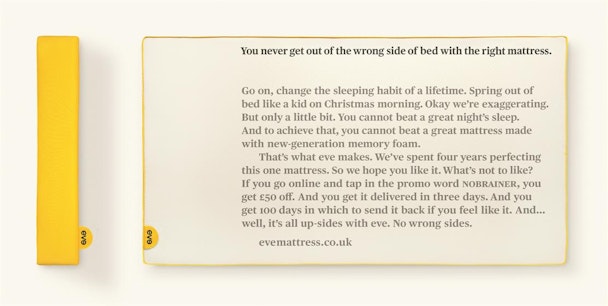Writing for design: Recognising the role of copy in the bigger picture
In the lead up to this year's D&AD Festival, Katie Ewer will be looking at what makes great writing for design in a series of blog posts this week. Katie is part of the 2016 jury for Writing for Design.

In this blog series we’ve looked at different kinds of writing for design, and we’ve looked at examples of great writing as well as poor writing. But what do we mean by ‘writing for design’ anyway?
The phrase ‘writing for design’ carries with it a significant clue. We’re talking here about a form of verbal communication that operates in partnership with the visual arts. ‘Writing for design’ isn’t about pure narrative, poetry, advertising jingles or taglines – it’s about a creative skill that must complement its visual context.
That doesn’t necessarily mean that writing always plays second fiddle to design. Some brands have personalities and cultures that are driven by the name, or the manifesto captured in the tone of voice. ‘First Direct’ – notions of innovation, to the point thinking and a sense of straight talking are all captured in the name, which, in turn, influenced the identity.

Perhaps the first thing to do is recognise the role of copy in the bigger picture (pun intended). Writing is great at functional, complex communication, www.gov.uk for example, and it can disarm with unexpected wit, I just love this chocolate bar from the Berkeley Hotel (above) that seems to see inside my very soul.
Writing can also do a lot of heavy lifting for a new brand by creating memorable names.
Take Farrow & Ball for instance: it certainly wasn’t the brand’s dull, anonymous visual identity that gave it resonance with paint lovers: that honour must surely fall to product names such as the notorious ‘elephant’s breath’.
When a brand’s voice is original, inventive and witty, we confer the same values on the brand itself. Take Eve Mattress (main picture), for instance – the brand’s easy-going long copy is the perfect complement to the brand’s bold and simple visual identity. The two disciplines work together seamlessly to build the brand idea.
In short, writing cannot do everything. It is not a substitute for a weak brand identity, nor can it disguise the absence of poor strategic thinking. But when used well, it’s a tool that can extend, enhance and complement design, whilst dramatising the brand strategy.
The fact that ‘writing for design’ is recognised as a discrete craft in its own right by the D&AD gives us a stage to interrogate it, a reason to value it, and an incentive to ensure we’re using words to their full potential in the field of design.
Katie Ewer is strategy director at JKR. Click on the links to catch up with the rest of the series - How to inject personality into your branding without becoming irritating, How to write with clarity, Writing for naming and Avoiding crimes against the written word.
